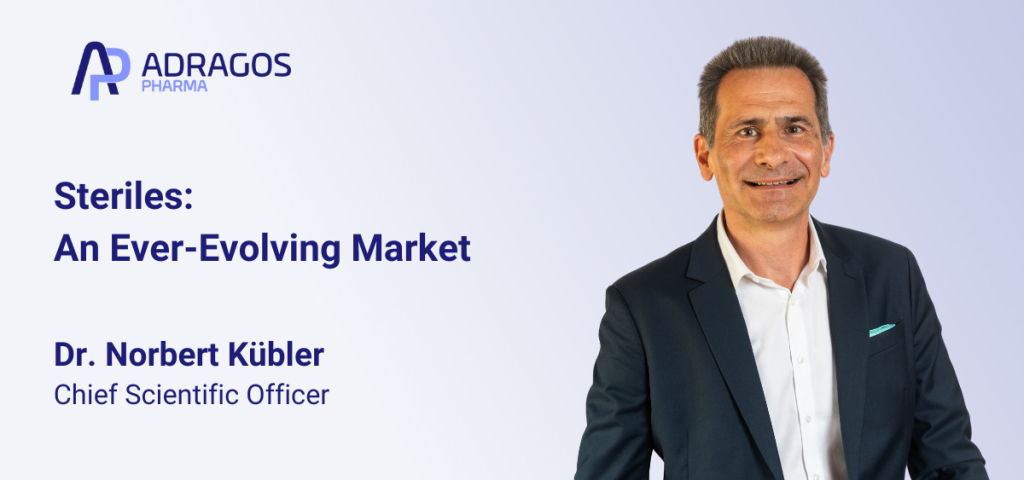The pharmaceutical industry is always evolving and advancing, and the world of sterile filling is no exception. Here at Adragos, steriles are one of our core competencies, and we keep a keen interest in how the market is progressing to keep us up to speed with what our customers require – and what they will be looking for in the future.
In recent years, product format trends have focused on ease of use, particularly for medicines that treat chronic diseases, and those designed for self-administration at home. Unsurprisingly, there are psychological barriers for many patients about injecting themselves, and easy-to-use self-administration systems are growing in importance.
There are essentially two types of self-injector. One is an single-injection system, usually containing a prefilled syringe, where the patient simply presses the autoinjector against their skin, pushes a button, and it’s done. The device includes some form of needle protection for safety, preventing the needle from causing injury after injection.
The second type, commonly used for drugs such as insulin and GLP-1 diabetes or weight-loss drugs, is cartridge-based. Multiple doses of the drug are included in a single glass or plastic barrel, and this is inserted into the autoinjector device. Variable dose sizes are possible, and the device can even be connected to a mobile phone app that alerts the patient when a dose is due, and tells them how much to administer. As well as optimising dose – it can be combined with glucose level monitoring for insulin, for example – this also allows physicians to monitor compliance, and whether the drug is controlling the blood sugar adequately.
Of course, these technological advances will come at a cost, and will not be affordable by patients in all countries. But the more they are used and accepted, then the cheaper they will become, and hopefully this will allow these beneficial features to be accessible to more patients in the future.
So what opportunities do these advances pose for those developing new sterile products? First and foremost, they can be a brand differentiator – but they also come at a cost, particularly if it is a one-off device designed for a specific product and company. A generic platform device would be cheaper, but for novel products poses less of a barrier to entry for future generic or biosimilar competition.
In the past, glass primary containers predominated in the steriles market, but they are increasingly being complemented by plastic alternatives. This has both upsides and downsides: the risk of glass breakage is removed, but it also increases the risk of interactions between the plastic and the formulation, so extractables and leachables need to be assessed for each individual product.
Manufacturing trends
Away from product formats, another trend in the sterile filling sector is the increased use of single use systems, transitioning away from traditional stainless steel equipment. This reduces complexity for cleaning and cross-contamination and thus saves time and reduces risks, but one downside is the increased amount of waste generated and the necessity of deeply understanding interactions of the drug product with the polymer surfaces.
Another change is a general shift from bulk components that require sterilisation before they are used to those that are pre-sterilised and ready to use. While for very large quantities it would still be more cost-effective to sterilise them in house, for small runs pre-sterilised stoppers and vials are likely to be preferable, with the additional benefit of reduced set-up times.
There have also been many developments in IT. It is now routine to monitor processes inline, with most, if not all, equipment integrated into an online operation. Advantages include electronic batch recording, the use of data directly read from the machine, and process verifications for generating documentation. It also provides a much better insight into the process, and any variability that may occur over time.
Another change we have seen in the past few years is the gradual shift towards biologics, which require additional analytical techniques. QC has needed to move forward to accommodate these advances, including the interactions between the drug molecules and the complete packaging system.
Scaling up steriles poses a range of problems, not least because it impacts so many product parameters. For example, if the medicine is temperature sensitive, then the increased process times required for larger batches can be problematic. Jacketed vessels are one way to reduce the risk, allowing them to be held at a lower temperature over a longer time.
Similarly, increased scale can affect the filling line. During the earlier stages of scale-up, the entire run may be completed in maybe half an hour, but as the batches get bigger, it might take five, or even 10, hours. This introduces further challenges for product quality, and ensuring it remains the same throughout.
The new breed of autologous cell therapies pose a different challenge: it is essential to minimise losses, and traditional batch approaches are not appropriate. Traditional sterility testing takes 15 days, for example, but this is not possible with these products that have to be administered within a day or two of manufacture. Real-time rapid product release is required, while still staying in compliance with all the relevant guidelines.
These are just a few of the trends we are experiencing across the sector. Here at Adragos, we believe it is essential to have a broad understanding of the changes within the market, whether it’s new product types and formats, or new technology that enable faster, more accurate production. By keeping ahead of the game, we will be better able to serve our customers, and their patients.

